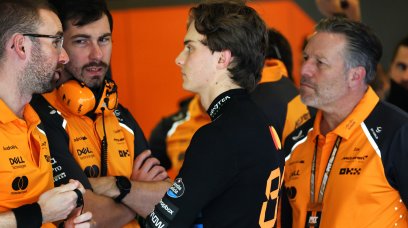Formula 1 drivers have been united in blaming the shortened DRS zones in Azerbaijan as the reason for the "boring" race weekend. The zones were reduced by 100m along one of the longest start/finish straights on the calendar prior to the race, in an attempt to create better overtaking in the opening corners. Instead it ended up in a lack of opportunities, as drivers sat behind in the dreaded 'DRS train' effect when those in front are unable to get close enough to pull off a move. Looking at the stats compared to 2022, it also made no difference to the overtaking moves made on track as it yielded the same result - 23. George Russell claimed that drivers were "not consulted" on the changes, while Max Verstappen said the weight of the cars plays a factor - these being the heaviest in the history of F1. Prior to the season, the F1 Commission announced that changes would be coming to five tracks to aid overtaking, including Bahrain, Jeddah, Melbourne, Baku and Miami. In Bahrain the lack of overtaking was noticeable compared to the 2022 season, with just 37 moves pulled off compared to 78 year-on-year. Saudi Arabia has always been a difficult track to overtake on given its high speed nature with just 36 overtakes (an improvement on 32 in 2022), while even with the fourth DRS zone reinstated Australia only produced 30 overtakes on track - four less than in 2022. Miami is set to also feature further changes with the first DRS activation point at Turn 9 reduced by 75m. But with drivers clearly feeling the changes are making it harder and evidence showing that it is not making a difference to overtaking moves on track, should F1 be looking at another way to utilise DRS?
All about the timing
In other championships such as IndyCar or Formula E, drivers have the use of extra horsepower (or battery power in Formula E) to get past rivals. In the domestic stateside series it is known as 'Push to Pass' which gives drivers an extra 40-50bhp to use for up to 20 seconds during the race. Formula E uses a similar 'Attack Mode' that adds another 30kW of battery power for 45 seconds, although with the caveat that it must be activated by going off the racing line. Both instances have time limits on their usage and given that DRS is effectively the same 'extra horsepower' effect on straights, why not do the same in F1? Give the drivers 40 seconds of usage throughout the race distance. This would not only cut out the problems the have with DRS trains, but would add a strategical element to the deployment of the wing. It would also be closer to the original intentions, which is to put drivers in a position to overtake rather than sail past with ease. It's not unfamiliar territory for F1's systems as it was used in GP3 (now F3) when it was introduced in the feeder series in 2017, with drivers restricted on the amount of laps they could use it for to six. Perhaps this would be a much better compromise for a system that will likely outstay its intended welcome, given the rate at which teams develop their cars and the effect it has on the intentions of regulations.
Most read








